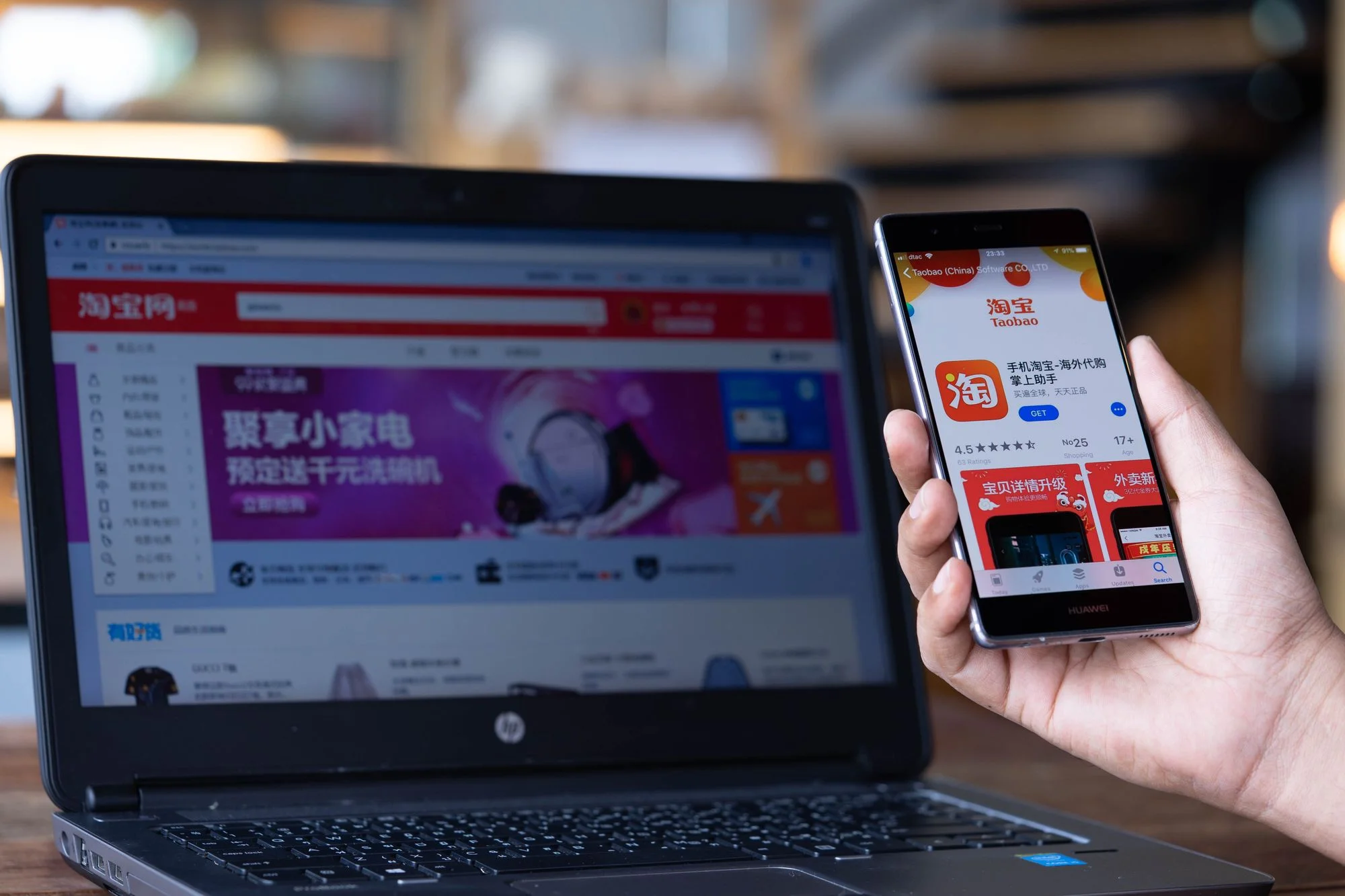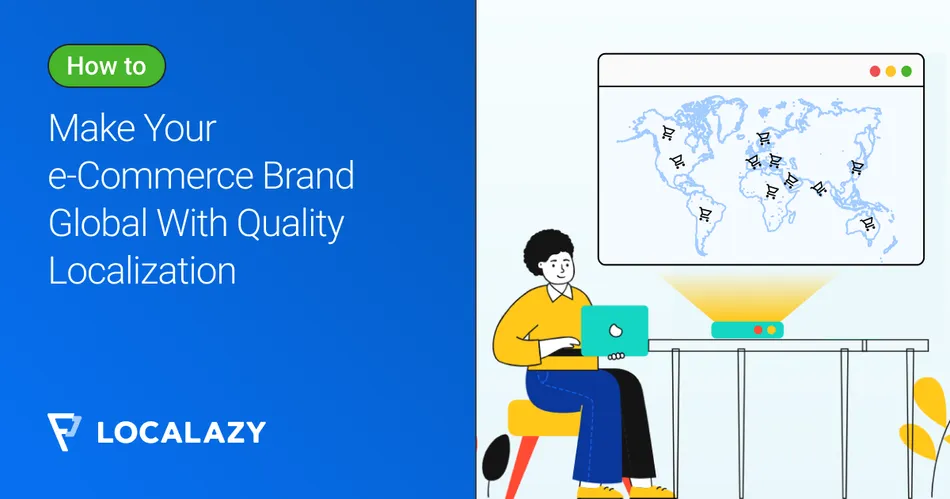Every brand can benefit from international expansion, and e-commerce companies are no exception. The statistics say that around 75% of internet users engage in some kind of e-commerce activity each month, and that number is guaranteed to grow. Online shopping has become a no-brainer, but the question is: What influences buyers' decisions, and how do you make your brand one of their go-to choices?
Winning the attention of potential buyers is one of the toughest equations to solve because many factors are involved. However, language is the primary element you should be concerned with. Presenting a brand's products in a language that people clearly understand and resonate with is the first step to selling more and building a global brand. That's when localization - the art of translating for local audiences - comes into play.

✈️ 7 steps to make your e-commerce global 🔗
To take an e-commerce brand global, you need localization. However, localization in itself is a comprehensive term that includes more elements than simply translating content accurately into the target language.
➡️ Here are some of the steps you should take to prepare your e-shop for international expansion:
1. Invest in a localized website 🔗
The first step to selling in multiple global markets is to prepare your website for localization. To do so, you'll need to internationalize it. Internationalization (i18n) is nothing but the preparation of your website for multiple languages. During this process, the code and the language are separated from one another, making it possible to provide language-switching without rewriting the code.
Some standard practices of internationalization include:
- 🧑💻 Encoding content in Unicode (UTF-8) to support all characters used in all the world's languages.
- 👁️ Developing the site with capabilities like the support of bidirectional text to prepare for future localization in foreign markets.
- 🔗 Setting up a site architecture and URL structures suitable for international browsing, etc.
After you are done with internationalization, you'll have to think about localization. Localization involves adapting your website to each market's local languages, payment methods, and cultural elements (more on this below).
If your shop is built on Shopify, some feature changes, like adjusting payments according to specific markets, can be easily executed. But when it comes to translating and localizing product descriptions and other components, your best bet is to integrate it seamlessly with localization software like Localazy and easily manage multiple localization options.
2. Build a diverse marketing team 🔗
To expand internationally, you'll need to tweak your practices according to international insights; and who can provide better insights than local experts in those regions? Having an international and diverse team isn't only important in adapting your message to local markets but also in gaining insights into the audience's shopping habits. 🕵️♀️
Different markets come with different audience habits, frequented channels, and demographics. The most efficient way to craft marketing that will appeal to these new audiences is by adding international experts to your team. If your e-commerce is still in the seed stage, these could very well be local freelance contractors with a deep knowledge of their market needs. Just remember to rely on local expertise to address your users' needs appropriately.

3. Ensure consistent quality across markets 🔗
Expansion comes with quality challenges. When selling in a new market, you should make sure the quality is the same as that of the original market. For instance, the quality of the product someone receives in the U.S. should be the same as the quality of the product someone will receive when ordering from Spain.
The challenge here is finding trustworthy suppliers if you partner with suppliers in your target markets. 🚚 You can't compromise on quality; otherwise, it will harm your brand reputation. While marketing to foreign audiences has its own challenges that need to be solved, maintaining quality should be your top priority.
4. Offer multilingual customer service 🔗
Your job is not done once the products are delivered. The support you provide for customers afterward is equally important. And when you expand to other markets, you can't expect to offer support in only one language, as that will confuse your buyers.
Hiring multilingual support agents who can converse with buyers and prospects to assist them in their buying journey or solve their issues will delight users and lead to more positive reviews. 📞 But this isn't all. When you provide multilingual support:
- ❇️ you will position your brand as highly reputable,
- 📉 reduce negative reviews and abandoned carts,
- 💌 and make it easier for customers to provide feedback.
Thanks to AI, providing multilingual support is much easier by adding AI-powered chatbots and customer support tools that require minimal human intervention. However, hiring local experts is still necessary to ensure that these tools help users and do not frustrate them.
5. Audit and adapt your UX 🔗
User experiences aren't uniform across cultures. An interface that appeals to a U.S. user could appear disrespectful to a Japanese user, even if the content is translated correctly. That's why you must audit and adapt the UX with:
- 🎏 appropriate imagery for the target markets,
- 🎨 relevant color schemes, layouts, and checkout flows,
- 🙏 and respecting thought processes, expectations, and regional norms.
UX localization has the power to make your brand appear local, and therefore compete with regional competitors for a greater share of the market. Multinational brands like Coca-Cola know the power of UX localization. That's why their U.S. and Japanese sites differ immensely.

6. Adapt to local pricing & preferences 🔗
In each country, residents have developed their favorite shopping habits after some time. For instance, shoppers from Asia-Pacific are more likely to purchase through TikTok (17%) than from Instagram (12%). Meanwhile, in Latin America, more are likely to shop via WhatsApp (14%) rather than from TikTok (2%) or YouTube (5%). You should consider such insights when expanding to new markets and focus on marketing through the channels your newfound audience uses the most locally.
Next, there are several practices you need to follow during localization, but one of the most fundamental ones when selling in a foreign market is to localize your pricing. Localized pricing not only makes your brand instantly appear like a local one, but it also enables you to match products with the market expectations, making it reasonable to buy. Now, you can implement:
- 💱 Cosmetic price localization - a simple currency-to-currency conversion.
- 🏷️ Or set completely new prices for each market based on other factors such as competition pricing, shipping rates, taxes, etc.
Both these approaches are used, but the second requires more work and yields better results.
When you're adapting to a new market, it is crucial to identify where your new audience shops the most and localize pricing, whether it is cosmetic or from scratch
7. Create content that resonates with locals 🔗
When entering new markets, you can't expect just to translate your old content and effectively connect with new audiences. Local cultures shape people's understanding and perceptions differently, which means that your listicles about the top trends in the U.S. won't appeal to readers in South Korea.
The ads you run across regions, the article topic you choose to work on, and the products you suggest should be based on local needs. Everything, from the language you use and the cultural norms you address to the complexity of the checkout process, should match the audience's needs and capabilities.

🚩 4 mistakes to avoid in e-commerce i18n 🔗
Making your e-commerce international comes with its own set of challenges and risks. Here are some mistakes you should avoid while expanding to a new region:
1. Not doing enough research 🔗
You can't do almost anything without research, and localization is no exception. You'll likely want to be listed across brands like Coca-Cola and Dolce & Gabbana but not on their list of localization blunders.
Therefore, make sure you research these points well if you're serious about succeeding in your expansion:
- 🛍️ Local consumer behaviors and purchasing habits for your niche.
- 📦 Policies around processes like taxation and shipping.
- 📢 What competitors offer and their marketing tactics.
- 💲 The most used local payment methods.
When researching your target market, find out whether there's demand for the products you're competing for with the pricing you have. This is the most critical metric.
Also, remember to look into the legal implications of selling in your target markets. Each country has its own policies. ⚖️ For instance, the EU has different regulations than the U.S. regarding data privacy and e-commerce rules. The EU's General Data Protection Regulation (GDPR) has strict requirements for collecting and processing its citizens' personal data. GDPR also applies to companies based outside the EU that market to EU users.
Pricing demand, local consumer behaviors, shipping and taxation policies and legal considerations are some of the factors that you'll need to look into to find out if your product is a good fit for a certain market
2. Ignoring local preferences for products in your niche 🔗
Although we mentioned this above, it deserves a section of its own because it's a common mistake. Your expansion success depends on how well you adapt to local preferences, which expand beyond the customers' favorite shopping channels.
Even simple details like color preferences and connotation matter. For instance, while the red color implies excitement and love in the U.S., it represents bloodshed and death in Africa. Similarly, other choices, like the type of scents preferred in each country, vary slightly. In Japan, people prefer products (like perfumes) with lighter scents than Europeans or Americans.
3. Rushing to launch in new markets 🔗
Launching to foreign markets is tricky. You need to take your time to process feedback and make the necessary changes. 📝 It's best to take it one market at a time with considerable breaks in between. If you try to do it all at once, you won't be able to adapt well or pay attention to details. Overlooked localization creates dissatisfied overseas customers.
If your focus is to expand to new markets as soon as possible, it makes sense to hurry. However, it's better to take more time for optimal results. Otherwise, you will fail to deliver.

4. Offering unsuitable payment options 🔗
Adding suitable payment methods is a no-brainer, but it can often be overlooked if you serve a broad customer base. Offering unsuitable payment methods will confuse you (and your customers) when your localization and marketing strategies don't yield satisfactory results. You might blame other factors, like translation quality, and probably change your content strategy only to discover that the payment method offered was causing the trouble.
Research which payment options—credit cards, mobile wallets, bank transfers, cash on delivery, etc.—are most frequently used in the target country. For example, 🇳🇱 iDEAL dominates in the Netherlands, 🇩🇪 SOFORT is preferred in Germany, and 🇨🇳 Alipay and WeChat Pay are ubiquitous throughout China.
Not offering these familiar local payment choices at checkout severely decreases conversion rates from international traffic. Even minor friction from unsuitable options can lead shoppers to abandon their carts.
⭐️ Top 3 benefits of e-commerce localization 🔗
Localization has been shown to increase the results of popular and not-so-popular brands worldwide, and it can surely do the same for any e-commerce brand. Here are three top benefits of applying it.
1. Reach a steady increase in international sales 🔗
At the end of the day, what matters are results, and results in e-commerce are pretty easy to measure. 🔍 You either get sales, or you don't. If you correctly apply the tactics we've mentioned, you should be selling into new markets successfully.
Couple your localization strategy with international SEO, and you will likely show in the faces of new potential customers and snatch their pockets. Even though the challenges are considerable, since you'll have to localize marketing messages, product descriptions, and articles and invest resources in market research, you'll be rewarded in sales.

2. Achieve a consistent global brand messaging 🔗
64% of people state that they have forged good relationships with brands with whom they share similar values. Without localization, it'll be challenging to maintain a trustworthy tone of voice and brand values. If you switch up your messaging whenever there's a new trend, people won't know what you stand for, making it hard to be favored.
A localization strategy ensures that your brand messaging isn't lost in translation when entering new markets. It sustains uniform messaging across regions, leading to a more loyal customer base because people regard your brand as more trustworthy.
3. Reduce support issues 🔗
Misunderstandings and miscommunication are the leading causes of contact with customer service and support teams. Such issues are common among customers who are native speakers of the primary language you've used in your shop, let alone those who aren't proficient in it. Imagine how many trivial issues you could solve through localization.
Localization tackles any miscommunication that could arise in product descriptions, visuals, or policies by clearly adapting them to your audience's local languages. It's worth mentioning that providing multilingual support is also part of the localization strategy, which means that even if customers have misunderstandings, they'll be resolved immensely faster when they talk with your multilingual staff.
Proper l10n of product descriptions, visuals and policies ensures that misunderstandings are less common among your global clientele, reducing support tickets
💡 Why Localazy is the ideal l10n solution 🔗
When choosing a localization platform, you should search for one that helps you achieve high-quality translations, manage your teams effortlessly, outsource the process if you want to, and accomplish all of these for an affordable price. Well, we're happy to offer all of these. Here's how:
Share TM: save money on translations 🔗
You can work with shared translations to cut localization costs. 💸 Our ShareTM feature suggests existing translations from 80+ languages from other translated apps on the platform for free reuse. This reuse lowers translators' workload and can save up to 50% on localization budgets.
Reviews: rest assured about high-quality 🔗
You can invite native speakers to contribute to your project while you are always leading the process, selecting which translations you approve or reject. This proactive review process makes it easier to attain quality translations. You can also provide translators with critical context via screenshots and descriptions to assist them in producing high-quality translations. Built-in tools boost quality without upping spend.

Progress tracker: keep track of changes 🔗
Localazy's dashboard centralizes activity across all languages and translated apps, allowing you to monitor progress in real-time. You can easily track the percentage of the translated project, new and modified strings, and more. You can also access the backlog anytime to check the version history for all translations.
📌 Final thoughts 🔗
These are just some of the features of Localazy, but we have countless other ones to make sure you reach new markets at full speed. Whether you're expanding your e-commerce store to one market or more, localization will give you an ace up your sleeve over your competitors. Click here to learn more about using localization to sell more in foreign markets and win a global customer base.




